Introduction:
The Bot Framework enables you to build bots that support different types of interactions with users. You can design conversations in your bot to be freeform. Your bot can also have more guided interactions where it provides the user choices or actions. The conversation can use simple text strings, the message with an attachment like the image, File (pdf, word, excel, ppt), mp3, Video or more complex rich cards.
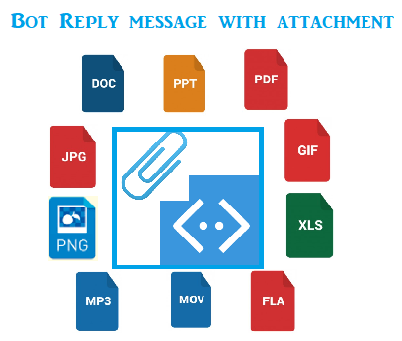
In this article, will help you to send a reply message with the different type of media file attachment.

Prerequisite:
I have explained about Bot framework Installation, deployment and implementation in the below article
Create New Bot Application:
Let's create a new bot application using Visual Studio 2017. Open Visual Studio > Select File > Create New Project (Ctrl + Shift +N) > Select Bot application.
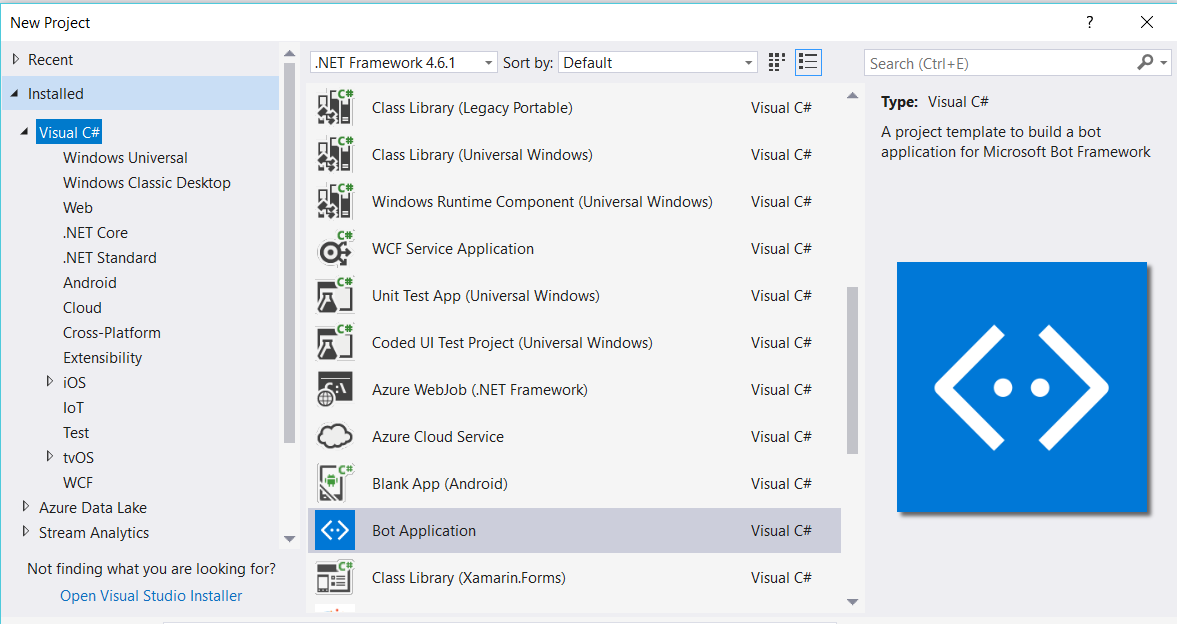
The Bot application template was created with all the components and all required NuGet references installed in the solutions.

Create New AttachmentDialog Class:
Step 1:
You can Create new AttachmentDialog class for show the attachment dialog. Right Click project > Select Add New Item > Create a class that is marked with the [Serializable] attribute (so the dialog can be serialized to state) and implement the IDialog interface.
using System;
using System.Threading.Tasks;
using Microsoft.Bot.Builder.Dialogs;
using Microsoft.Bot.Connector;
using System.IO;
using System.Web;
using System.Collections.Generic;
namespace BotAttachment.Dialogs
{
[Serializable]
public class AttachmentDialog : IDialog<object>
{
Step 2
IDialog interface has only StartAsync() method. StartAsync() is called when the dialog becomes active. The method is passed the IDialogContext object, used to manage the conversation.
public async Task StartAsync(IDialogContext context)
{
context.Wait(this.MessageReceivedAsync);
}
Step 3:
Create a MessageReceivedAsync method and write following code for the welcome message and show the list of demo options dialog.
private readonly IDictionary<string, string> options = new Dictionary<string, string>
{
{ "1", "1. Attach Local-Image " },
{ "2", "2. Attach Internet Image" },
{"3" , "3. File Attachment" },
{"4" , "4. Get local PDF" },
{"5" , "5. Video Attachment" },
{"6" , "6. Youtube video Attachment" },
{"7" , "7. MP3 Attachment" },
};
public async virtual Task MessageReceivedAsync(IDialogContext context, IAwaitable<IMessageActivity> result)
{
var message = await result;
var welcomeMessage = context.MakeMessage();
welcomeMessage.Text = "Welcome to bot Attachment Demo";
await context.PostAsync(welcomeMessage);
await this.DisplayOptionsAsync(context);
}
public async Task DisplayOptionsAsync(IDialogContext context)
{
PromptDialog.Choice<string>(
context,
this. SelectedOptionAsync,
this.options.Keys,
"What Demo / Sample option would you like to see?",
"Please select Valid option 1 to 6",
6,
PromptStyle.PerLine,
this.options.Values);
}
public async Task SelectedOptionAsync(IDialogContext context, IAwaitable<string> argument)
{
var message = await argument;
var replyMessage = context.MakeMessage();
Attachment attachment = null;
switch (message)
{
case "1":
attachment = GetLocalAttachment();
replyMessage.Text = "Attach Image from Local Machine";
break;
case "2":
attachment = GetInternetAttachment();
replyMessage.Text = "Attach Image from Internet";
break;
case "3":
attachment = GetinternetFileAttachment();
replyMessage.Text = "Click Link for navigate PDF internet location";
break;
case "4":
attachment = GetLocalFileAttachment();
replyMessage.Text = "Click Link for navigate PDF local location"
break;
case "5":
attachment = GetinternetVideoAttachment();
replyMessage.Text = "Click on play button ";
break;
case "6":
attachment = GetinternetYoutubeAttachment();
replyMessage.Text = "Showing video from Youtube ";
break;
case "7":
attachment = GetinternetMP3Attachment();
replyMessage.Text = "Showing MP3 from internet ";
break;
}
replyMessage.Attachments = new List<Attachment> { attachment };
await context.PostAsync(replyMessage);
await this.DisplayOptionsAsync(context);
}
After user enter the first message, bot will reply welcome message and list of demo option and wait for user input like below
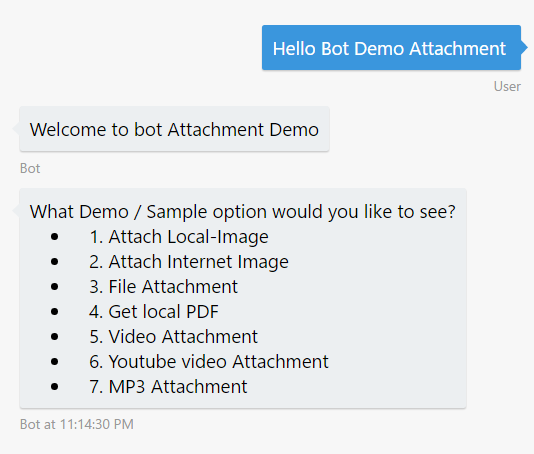
Step 4: Local Image Attachment:
The following code showing for reply message with image, to add image as an attachment to a message, create an Attachment object for the message activity and set following
ContentType
ContentUrl
Name
///
/// dispaly local image
///
///
private static Attachment GetLocalAttachment()
{
var imagePath = HttpContext.Current.Server.MapPath("~/images/demo.gif");
var imageData = Convert.ToBase64String(File.ReadAllBytes(imagePath));
return new Attachment
{
Name = "demo.gif",
ContentType = "image/gif",
ContentUrl = $"data:image/gif;base64,{imageData}"
};
}
After user provides inpute, Bot will reply message with local image like below

Internet Image Attachment:
The Internet image option is the simplest but requires the image to be already on the Internet and be publicly accessible. provides a content Url pointing to image url path.
///
/// Dispaly image from internet
///
///
private static Attachment GetInternetAttachment()
{
return new Attachment
{
Name = "architecture-resize.png",
ContentType = "image/png",
ContentUrl = "https://docs.microsoft.com/en-us/bot-framework/media/how-it-works/architecture-resize.png"
};
}
The following output screen showing, after user provides the input, bot will fetch image from internet and display in emulator
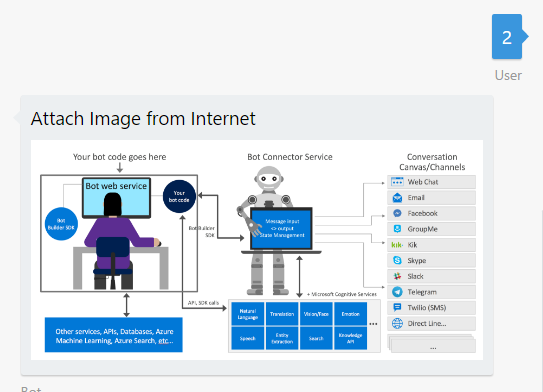
Internet File Attachment:
You can refer following code for add hyperlink to fetch file from internet and attach to reply message, same code will be reuse for all the type of document but need to change content type and content url
///
/// attach internet file
///
///
public static Attachment GetinternetFileAttachment()
{
Attachment attachment = new Attachment();
attachment.ContentType = "application/pdf";
attachment.ContentUrl = "https://qconlondon.com/london-2017/system/files/presentation-slides/microsoft_bot_framework_best_practices.pdf";
attachment.Name = "Microsoft Bot Framework Best Practices";
The following output screen, after user provides input, bot will reply message with hyperlink for document, user need to click a hyperlink for open the document

Local File Attachment:
You can add pdf file into your project and add the following code for attach local pdf document in reply message
///
/// Get local file
///
///
public static Attachment GetLocalFileAttachment()
{
var pdfPath = HttpContext.Current.Server.MapPath("~/File/BotFramework.pdf");
Attachment attachment = new Attachment();
attachment.ContentType = "application/pdf";
attachment.ContentUrl = pdfPath;
attachment.Name = "Local Microsoft Bot Framework Best Practices";
return attachment;
}
The following output showing reply message with hyperlink for download attached pdf document

Video Attachment:
The following code showing reply message with attach video file
///
/// Dispaly video from internet
///
///
public static Attachment GetinternetVideoAttachment()
{
Attachment attachment = new Attachment();
attachment = new VideoCard("Build a great conversationalist", "Bot Demo Video", "Build a great conversationalist", media: new[] { new MediaUrl(@"https://bot-framework.azureedge.net/videos/skype-hero-050517-sm.mp4") }).ToAttachment();
return attachment;
}
The following output showing, after user provides input ,bot will reply message with video attachment
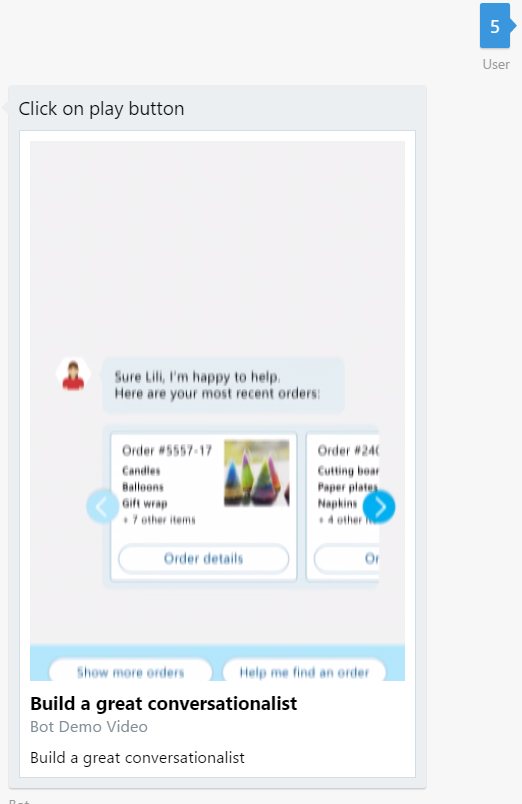
YouTube Video Attachment:
The following code showing replay message with attach YouTube video . you need to Provides contentype and content url in Attachment property
///
/// Display Youtube Video
///
///
public static Attachment GetinternetYoutubeAttachment()
{
Attachment attachment = new Attachment();
attachment.ContentType = "video/mp4";
attachment.ContentUrl = "https://youtu.be/RaNDktMQVWI";
return attachment;
}
The following output showing, message with youtube video attachment
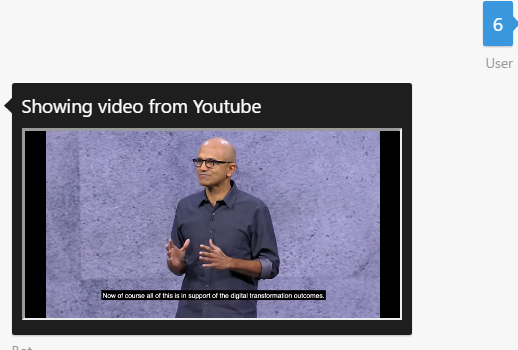
MP3 File Attachment:
The following code showing, attached mp3 file in a reply message, the attachment type is in the Content Type property, which should be a valid mime type is “image/mpeg3” or “audio/mp3”.
///
/// attach internet file
///
///
public static Attachment GetinternetMP3Attachment()
{
Attachment attachment = new Attachment();
attachment.ContentType = "audio/mpeg3";
attachment.ContentUrl = "http://video.ch9.ms/ch9/f979/40088849-aa88-45d4-93d5-6d1a6a17f979/TestingBotFramework.mp3";
attachment.Name = "Testing the Bot Framework Mp3";
return attachment;
}
The output showing reply message with attached mp3 file

Run Bot Application
The emulator is a desktop application that lets us test and debug our bot on localhost. Now, you can click on "Run the application" in Visual studio and execute in the browser

- Test Application on Bot Emulator
- You can follow the below steps to test your bot application.
- Open Bot Emulator.
- Copy the above localhost url and paste it in emulator e.g. - http://localHost:3979
- You can append the /api/messages in the above url; e.g. - http://localHost:3979/api/messages.
- You won't need to specify Microsoft App ID and Microsoft App Password for localhost testing, so click on "Connect".

Summary
In this article, you learned how to create a Bot application using Visual Studio 2017 and sending a reply message with the different type of media file attachment. If you have any questions/feedback/ issues, please write in the comment box.










